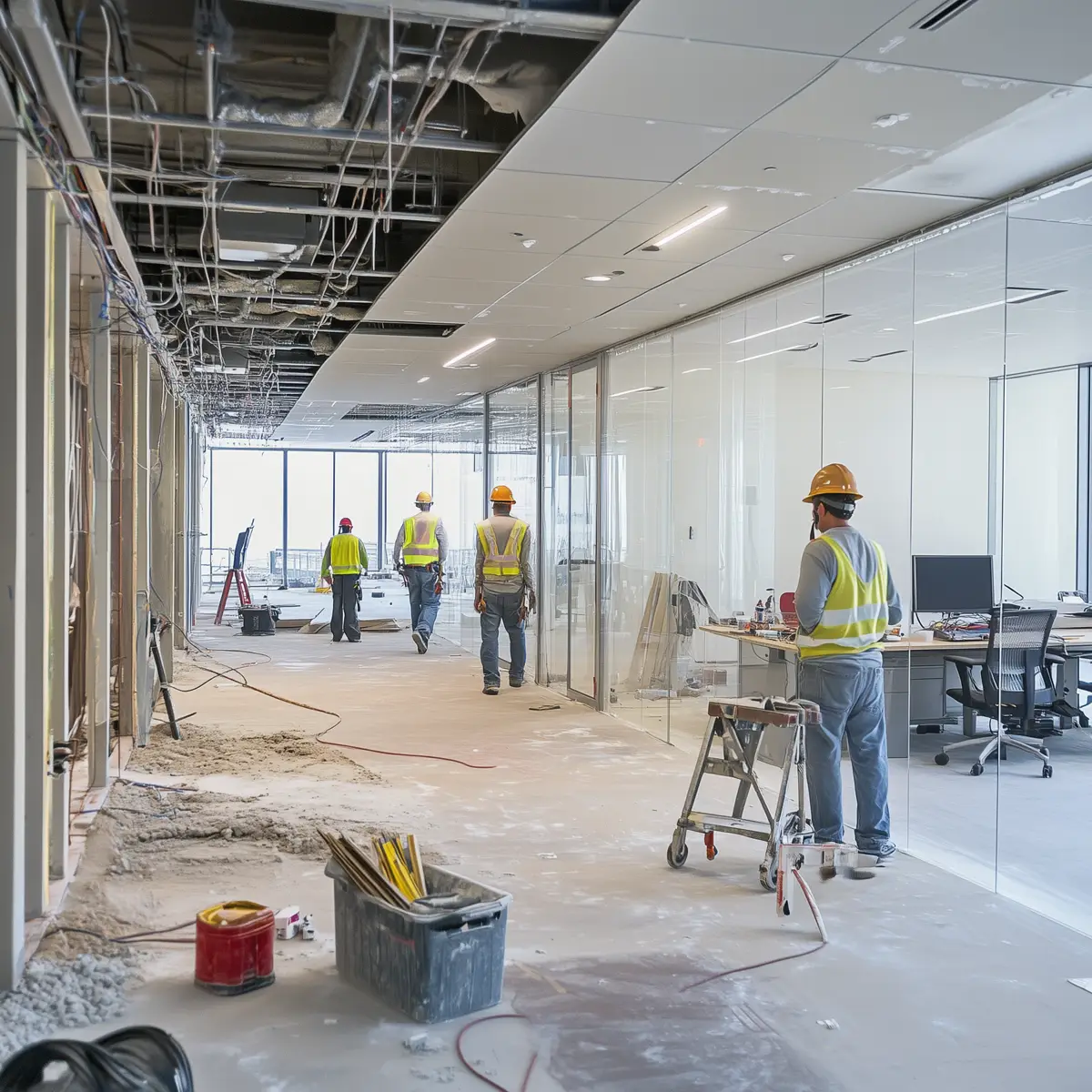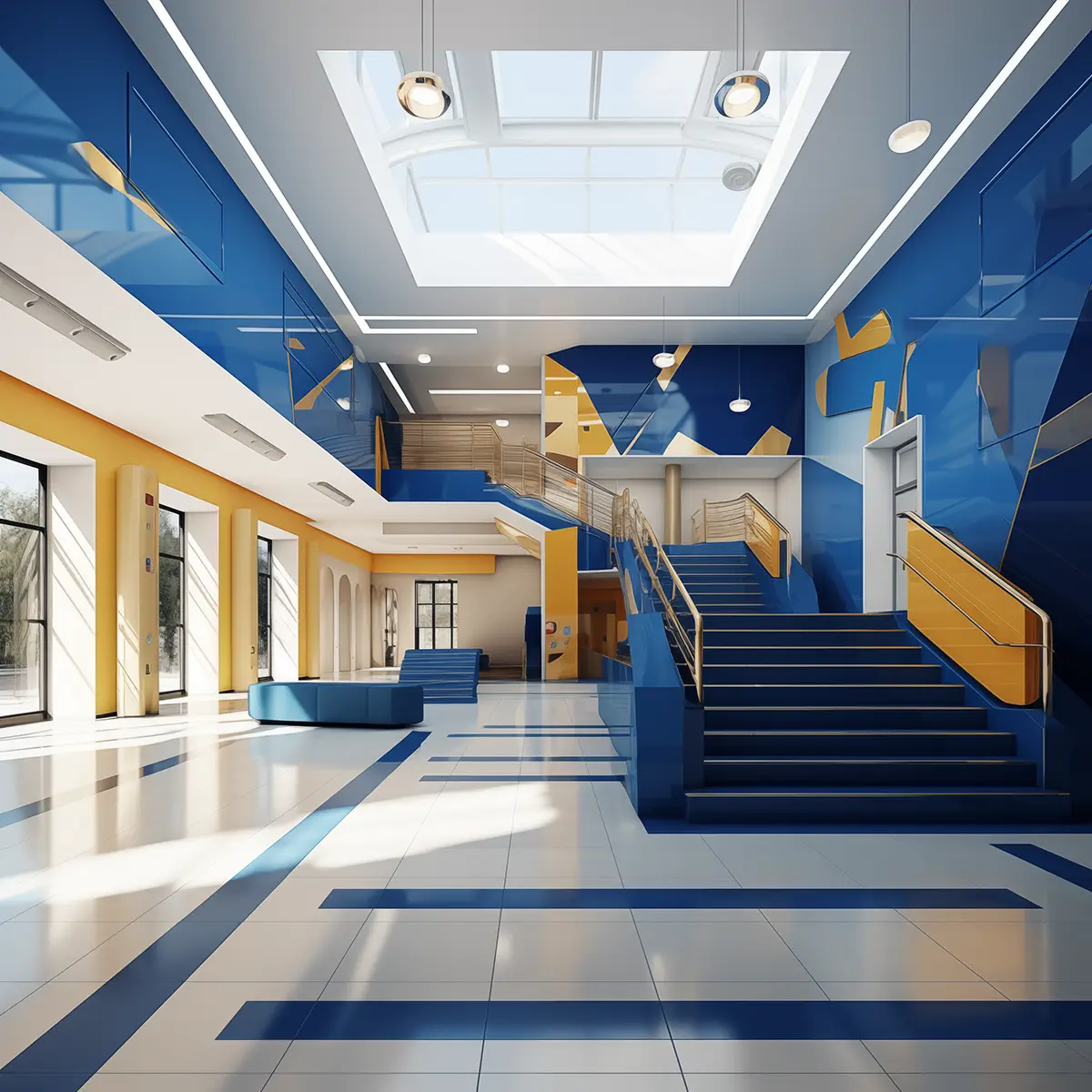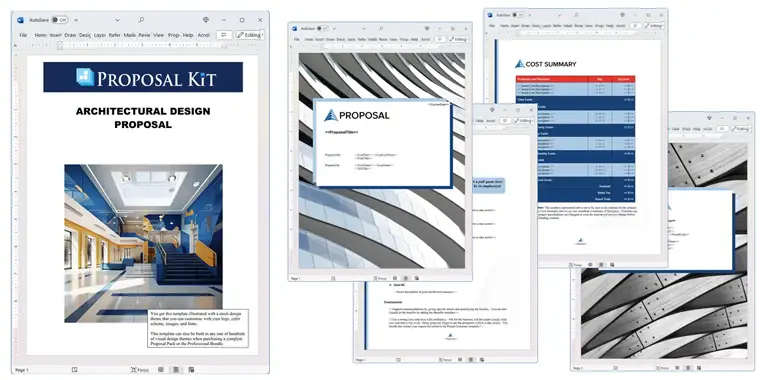How to write your Architectural Design Proposal
We include this 19 page layout with every Proposal Pack. If you want this template to have a different visual design theme than the one illustrated here, purchase any Proposal Pack design and create this template using the purchased design theme. This template is included in every Proposal Pack. If you get a Proposal Pack or the Professional, you can also make any variation of this template with different chapters to suit your needs.
We typically include more chapters in the templates than most people will need to give everyone more variety in the chapters they may need. You can trim down a long template by removing pages you do not need or combining multiple chapter topics into one page.
 DOWNLOADABLE, ONE-TIME COST, NO SUBSCRIPTION FEES
DOWNLOADABLE, ONE-TIME COST, NO SUBSCRIPTION FEES![]() View Architectural Design Sample Proposal
View Architectural Design Sample Proposal
This sample proposal is based on the same layout as this template and is included in every Proposal Pack. The visual design of the templates will match whichever Proposal Pack design you purchase. To get this template in a different design theme than shown in the sample, purchase any other Proposal Pack design theme and this template will be included.
You can create an editable Word version of this sample in any design theme of your choice including branded to your logo.
 If you need only this template pre-assembled on DVD media order from our Amazon shop.
If you need only this template pre-assembled on DVD media order from our Amazon shop.
You can also create countless variations of this document to suit your needs using the included library of 2200+ chapters if ordering a Proposal Pack or Professional.
 What Our Clients Say
What Our Clients SayThis is a great product specially for grant writer. I have been using it since 2014."
Related Article
Related Video
Related Templates
- Real Estate Resort Development Sales Proposal
- Real Estate Land Development Proposal
- Office Renovation Proposal
- Contractor Bath and Kitchen Remodel Services Proposal
- Office Bathroom Renovation Project Proposal
- Custom Home Building Proposal
- Home Construction Proposal
- Contractor Home Remodel Services Proposal
- Commercial Contracting Office Remodel Proposal
- Civil Engineering Construction Project Proposal
- Roofing Contractor Proposal
- Architecture Proposal Template
- Architecture Firm Proposal Template
- Steel Erection Project Proposal
- Industrial Design Project Proposal
What's the best way to write your architectural design proposal?
A proven option is to use a comprehensive tool like the Proposal Kit template and software package. This system offers a wide range of customizable templates and includes a sophisticated line item quoting database for creating detailed cost summaries, quotes, estimates, budgets, and other financial documents.
Are you tasked with writing an architectural design proposal for a complex project? Then, the Proposal Kit is your essential tool for success.
What Types of Projects Are Architectural Design Proposals Written For?
Architectural design proposals are written for many types of projects, such as:
- New school buildings
- Hospital and healthcare facilities
- Residential housing developments
- Commercial office buildings
- Retail shopping centers
- Sports facilities
- Cultural institutions like museums
- Transportation infrastructure, such as train stations
- Government buildings
- Hotels and resorts
- University campuses
- Historical building renovations
- Public parks and recreation centers
- Industrial complexes
- Mixed-use developments
- Eco-friendly and sustainable buildings
- Emergency and disaster-resistant constructions
- Urban planning projects
- Landscaping architecture
- Interior design projects
Chapters this template is built with
While no template can suit every need, Proposal Kit software allows you to create tailored proposals with its extensive library. This flexibility ensures that your architectural design proposal perfectly aligns with your project's specifics.
Each document is a Word format template that, once customized, can be saved as a PDF for delivery.
Below are commonly used chapters that you can customize for your proposal:
Cover Letter
Introduce your architectural firm and summarize your project vision. Highlight your firm's previous successes, emphasize your unique selling points, and briefly overview the project's significance. This will set the stage for the rest of the document and establish credibility from the outset.
Introduction
Detail the project scope and objectives. This section clearly explains the client's needs and how your design will fulfill those needs. Include the key goals, such as enhancing learning environments for a new school building, and outline the benefits of your proposed solution.
Architecture
Discuss the architectural concepts and structural design. This is where you look into the technical aspects of your design, including the building's layout, structure, and aesthetic components. Use diagrams and sketches to provide a visual representation of your ideas.
Style
Describe the aesthetic and design styles of the building. Specify whether the design will be modern, classical, or a hybrid. Discuss how the style fits the surrounding environment and meets the project's functional needs.
Concepts
Explain innovative design concepts being considered. Whether incorporating smart building technology or sustainable design practices, this section should highlight how your project stands out in terms of creativity and innovation.
Environmental
Address environmental impact and sustainability measures. Detail how the building will use green technologies, energy-efficient systems, and sustainable materials. Discuss how your design aligns with environmental standards and contributes to ecological conservation.
Security
Outline the security features planned for the building. Explain how the design incorporates safety measures such as secure entry points, surveillance systems, and fire safety protocols. This is particularly crucial for facilities like schools, where safety is a top priority.
Flexibility
Talk about adaptable design elements for future needs. Describe how the building can be modified or expanded, making it a long-lasting solution for the client. Highlight features such as modular classrooms or expandable office spaces.
Space Planning
Explain the layout and functional use of spaces. Provide a detailed breakdown of how various areas within the building will be used. This could include classrooms, administrative offices, gyms, and school common areas. Use floor plans to illustrate space allocation.
Building Codes
Ensure compliance with local and international building codes. This section should demonstrate your understanding of relevant regulations and standards and how your design adheres to these requirements. Include references to specific codes and standards applied.
Blueprints
Present detailed blueprints and schematics. These technical drawings should offer a comprehensive view of the building's design, including floor plans, elevations, and sections. Ensure that these blueprints are clear and professionally presented to aid understanding.
Materials
List materials and technologies used in construction. Provide a detailed inventory of the materials you plan to use, including their benefits and why they were chosen. Discuss innovative construction technologies that will be employed, such as prefabrication or 3D printing.
Fee Structure
Break down the costs and outline the payment schedule. Offer a transparent and detailed cost estimation, covering everything from materials and labor to administrative fees and contingencies. Outline the payment terms and conditions to manage client expectations.
Next Steps
Propose the subsequent phases of the project post-approval. This section should provide a clear roadmap, including key milestones, timelines, and responsibilities. It helps the client understand what to expect and keeps the project on track.
About Us
Provide background information about your architecture firm. Share your firm's history, mission, and vision. Highlight your experience, expertise, and any awards or recognitions your firm has received. This will build trust and establish your firm's credibility.
Team Members
Introduce key team members and their roles. Include brief bios of the principal architects, project managers, and key personnel. Highlight their qualifications, experience, and specific roles in the project. This personal touch can create a connection with the client.
Use cases for this template
Securing a New School Building Contract
Julia, the owner of DreamDesigns Architecture, was on the cusp of a significant business milestone - securing a contract for designing a new elementary school. Understanding the competitive landscape, she knew her proposal had to stand out not just in design but also in demonstrating her firm's expertise. She turned to Proposal Kit to create an architectural design proposal.
With Proposal Kit's extensive library, Julia customized her proposal to emphasize her company's experience in educational architecture. She employed templates for the Cover Letter, Introduction, and Architecture sections to detail her firm's qualifications and vision for the project. The Style and Concepts templates enabled her to describe the innovative educational spaces she envisioned vividly her envisioned innovative educational spaces.
Julia also used the Environmental and Security templates to highlight sustainable building practices and essential safety features for the school. By incorporating the Fee Structure template, she provided a transparent and detailed cost breakdown that reassured the client.
The final proposal, a document saved as a PDF, showcased DreamDesigns Architecture's commitment to creating a state-of-the-art learning environment. The school board was impressed by the thoroughness and clarity of the proposal, which awarded Julia the project, which was a significant win for her small business.
Meeting a Tight Deadline for a Corporate Office Proposal
Eli, a lead architect at BuildRight Ventures, found himself in a race against time. The firm had just received a last-minute opportunity to bid on a high-profile corporate office building project. The deadline was tight, and the stakes were high. Eli needed an efficient way to create a winning proposal quickly.
He turned to Proposal Kit and an AI writing tool to expedite the process. Using Proposal Kit's robust architecture design templates, Eli started with the Cover Letter and Introduction to set the stage for his firm's capabilities. The Architecture and concept templates helped him articulate the innovative design and intelligent office concepts they planned to incorporate.
For the Space Planning and Flexibility sections, Eli used the AI tool to analyze BuildRight Ventures' website, extracting relevant content that was refined and inserted into the proposal. This saved precious hours and ensured the proposal was both detailed and personalized.
The Environmental and Materials templates allowed Eli to showcase eco-friendly practices and cutting-edge materials, while the Fee Structure template provided a clear and competitive cost outline. Using Proposal Kit and AI, Eli completed a comprehensive proposal with time to spare. The client was impressed by the quality and depth of the proposal, leading to a successful bid for BuildRight Ventures.
Creating an RFP for Community Center Renewal
Tina, a director at Community First, was tasked with preparing a Request for Proposal (RFP) for renovating an old community center. The project was critical for the community, and Tina needed to ensure that the RFP attracted the right architectural firms who could deliver on the vision.
Using the Proposal Kit, Tina structured a detailed and precise RFP. She began with the Cover Letter and Introduction templates to outline the purpose and scope of the project. The Space Planning and Building Codes templates were invaluable in detailing the specific requirements and compliance standards needed for the renovation.
Tina used the Environmental and Style templates to emphasize the importance of sustainable practices and the desired aesthetic for the community center. By including the Fee Structure template, she provided a transparent budget framework to guide potential bidders.
The final RFP, formatted and saved as a PDF, was a well-organized document that communicated the non-profit's needs and expectations. The clarity and professionalism of the RFP attracted numerous qualified contractors, ensuring that Community First could choose the best partner for their community center renewal project.
Conclusions and Recommendations
Proposal Kit has proven invaluable in creating detailed, persuasive architectural design proposals for small businesses, large corporations, and non-profits. Whether meeting a tight deadline, outlining complex project details, or ensuring financial clarity, Proposal Kit helps users achieve their goals and win contracts effectively.
Also Known As
This template may also be referred to in different ways or be used in more specialized situations, such as:
- Architectural Proposal
- Design Submission
- Building Concept Proposal
- Construction Project Proposal
- Facility Design Submission
- Architectural Plan
- Structure Design Proposal
- Architectural Bid Document
- Design Project Proposal
- Architecture Request for Proposal
Abstract
 You can use Proposal Kit templates to easily fill in your Cover Letter, Executive Summary, and main sections of your architectural proposal. Writing architectural proposals for complex projects doesn't have to be daunting; with these tools, you can develop a comprehensive document that impresses potential clients and project stakeholders.
You can use Proposal Kit templates to easily fill in your Cover Letter, Executive Summary, and main sections of your architectural proposal. Writing architectural proposals for complex projects doesn't have to be daunting; with these tools, you can develop a comprehensive document that impresses potential clients and project stakeholders.
By showcasing your architectural design services and highlighting previous successful projects, you demonstrate your team's qualifications and relevant experience. Include a detailed proposal with a project description that outlines the project's scope, key aspects, and your architect's vision. Use high-resolution images from past projects to capture the reader's interest and convey your design philosophy.
Discuss important elements like project cost, cost estimates, and your architect's fees, whether it's a flat fee or a percentage-based fee. Providing a clear understanding of the total cost helps potential clients make informed decisions. Outline project milestones and a timeline to show your project management skills and ability to meet exact specifications.
 Address the client's requirements by including a detailed overview of the functional requirements and how you plan to meet them. Talk about your design approach, sustainability goals, and any additional services you offer. This ensures clients understand the value you bring and helps prevent scope creep.
Address the client's requirements by including a detailed overview of the functional requirements and how you plan to meet them. Talk about your design approach, sustainability goals, and any additional services you offer. This ensures clients understand the value you bring and helps prevent scope creep.
Using the Proposal Kit templates streamlines the proposal process, saving valuable time and effort. The templates allow architects to present information in an organized manner, ensuring consistency and professionalism. By tailoring your proposal to the client's goals and highlighting key aspects, you increase your chances of moving forward with the project.
Include an architect's qualification statement and a summary of your team's qualifications to build trust. Discuss any similar projects you've completed to demonstrate your ability to handle the new project's challenges. Provide clear instructions and communicate effectively to keep the potential client's interest.
 By adopting these strategies and utilizing Proposal Kit, you can create architectural proposals that not only meet but exceed client expectations. This approach allows you to focus on developing creative solutions while ensuring all crucial tools and components are addressed, ultimately leading to successful projects and satisfied clients.
By adopting these strategies and utilizing Proposal Kit, you can create architectural proposals that not only meet but exceed client expectations. This approach allows you to focus on developing creative solutions while ensuring all crucial tools and components are addressed, ultimately leading to successful projects and satisfied clients.
Frequently Asked Questions
What are the essential components of an architectural design proposal?
An architectural design proposal should include several key elements to ensure it is comprehensive and convincing. Important components typically include a cover letter, an introduction that outlines the project scope and objectives, detailed architectural design concepts, aesthetic styles, and environmental considerations. Additionally, it should feature security plans, space planning, blueprints, materials to be used, a fee structure, and next steps. Using Proposal Kit, you can customize these components with specific templates tailored to the unique requirements of your architectural design proposal.
How do I make my architectural design proposal stand out?
To make your architectural design proposal stand out, focus on clarity, detail, and presentation. Visual elements like blueprints, sketches, and 3D models illustrate your design concepts. Clearly outline the benefits of your proposed design, such as how it meets the client's needs and adheres to sustainability practices. Personalize your proposal by addressing the client's specific requirements and demonstrating your understanding of the project's goals. With Proposal Kit's extensive library of templates, you can easily create a well-organized and visually appealing proposal that captures the client's attention.
How can I accurately estimate costs in my architectural design proposal?
Accurate cost estimation is crucial in an architectural design proposal to build trust and avoid future misunderstandings. Use the line item quoting database system included in the Proposal Kit to create detailed cost summaries, quotes, estimates, and budgets. Break down costs into materials, labor, permits, and contingencies. Providing a transparent and detailed fee structure helps the client understand the financial aspects of the project and demonstrates your professionalism and thoroughness.
What should I include in the environmental section of my architectural design proposal?
The environmental section of an architectural design proposal should address sustainability and environmental impact. Discuss how your design incorporates eco-friendly materials, energy-efficient systems, and sustainable practices. Highlight certifications or standards your design meets, such as LEED or BREEAM. Use Proposal Kit templates to provide detailed information on how your proposal aligns with environmental goals and reduces the project's carbon footprint. This section is increasingly essential for clients who prioritize sustainability in their projects.
How do I ensure my architectural design proposal complies with building codes?
Compliance with building codes is an essential aspect of any architectural design proposal. The building codes section outlines how your design meets local, state, and federal regulations. Include references to specific codes and standards that apply to the project. Use Proposal Kit's templates to ensure you cover all necessary compliance topics, such as safety standards, accessibility requirements, and zoning laws. Thoroughly addressing these issues in your proposal demonstrates your expertise and commitment to delivering a legally compliant project.
20% Off Discount
![]() Add To Cart This Word Template
Add To Cart This Word Template
 Add To Cart Proposal Pack Architecture #4
Add To Cart Proposal Pack Architecture #4
 Add To Cart Proposal Kit Professional
Add To Cart Proposal Kit Professional
 4.7 stars, based on 848 reviews
4.7 stars, based on 848 reviewsProposal Kit chapters used in this template
Cover Letter, Title Page, Table of Contents, Introduction, Architecture, Style, Concepts, Environmental, Security, Flexibility, Space Planning, Building Codes, Blueprints, Materials, Fee Structure, Next Steps, About Us, Team Members, Back Page
Line Item Automated Chapters
If you purchase a Proposal Pack or the Professional Bundle, these proposal pages are generated using an automated line-item database in the included Wizard software.
Fee Structure
You use this proposal for
- General business proposal
- Non-technical proposal
- Project pitch proposal
- Construction, contracting, building proposal
- Real estate, property proposal
How to create this template with Proposal Pack Wizard
You can create this document using any of the logo-designed Proposal Packs. Pick any Proposal Pack with a logo design theme you like best; they will all work equally well. The Proposal Pack for Any Business is the pack with no extra added logos or colors - designed to be used plain or for you to customize with your logos and graphics.
The Proposal Pack design theme you purchase will determine the visual look of this template. The screenshot above only shows the plain generic design theme.
We include a library of chapters to be assembled based on your needs. All proposals are different and have different needs and goals. We designed Proposal Pack so you can customize the documents to suit your needs.
You will best create this document using the Proposal Pack Wizard - Expert Edition software to select this template and build it in the Proposal Pack logo design theme of your choice along with any desired customizations (such as adding additional chapters, removing unneeded chapters, changing the order of chapters, and importing your company logo). This template outlines a proposal for the described situation. Each user is responsible for typing in the actual content of the provided pages with their information to complete the proposal. Suggestions in the abstract may include features in higher-end packages and are facilitated by the selection of chapter templates to support the narrative of each proposal, which help guide the user in filling in the details.
The Wizard software's AI Writer will write the content of the pages of the template based on details provided for your company, client, project, financial details and other writing instructions. This will provide a personalized version of the template completely written and ready to edit.
Once finished, the AI Writer's Word-to-PowerPoint converter can transform your proposal, business plan, or other business documents into a PowerPoint slideshow. Save time and effort by letting the AI analyze every chapter to condense its content into talking points, visually matching the document, and providing a consistent package of presentation material with the click of a button.
You create this template using the Wizard software with an entire Proposal Pack library and software. We include the Expert Edition of the software in the Proposal Kit Professional. Microsoft Word for Windows is required to use the customizing software. You can also edit Word document templates in other office software such as Word for Mac. We will assist Mac users in assembling complex templates for their first project if they do not have the required platform to run the Wizard software.
How to Build Templates Featured on Proposal Kit Website
Many people find the Proposal Kit website after searching for a specific proposal. Once you've purchased and installed the software, how do you build that template you found in the first place? This video shows you how to build any proposal you see on the Proposal Kit website.
 Ian Lauder has been helping businesses write their proposals and contracts for two decades. Ian is the owner and founder of Proposal Kit, one of the original sources of business proposal and contract software products started in 1997.
Ian Lauder has been helping businesses write their proposals and contracts for two decades. Ian is the owner and founder of Proposal Kit, one of the original sources of business proposal and contract software products started in 1997.By Ian Lauder
 Published by Proposal Kit, Inc.
Published by Proposal Kit, Inc.


 Cart
Cart
 Get 20% off ordering today:
Get 20% off ordering today: 


 Facebook
Facebook YouTube
YouTube Bluesky
Bluesky Search Site
Search Site